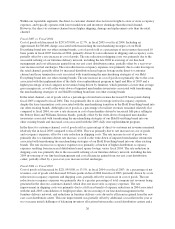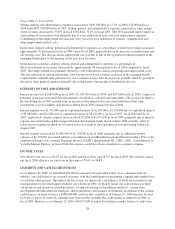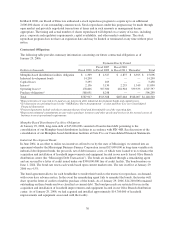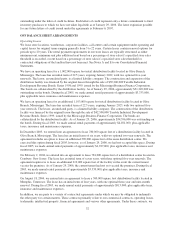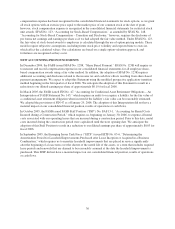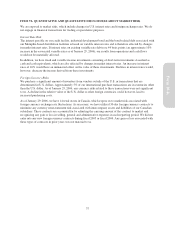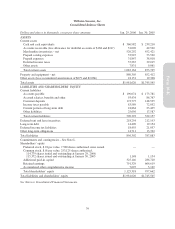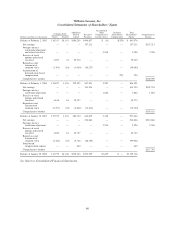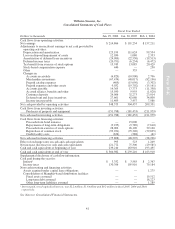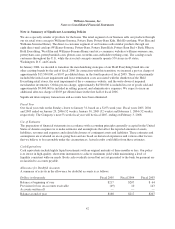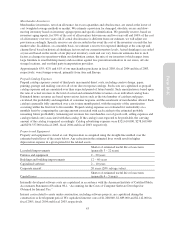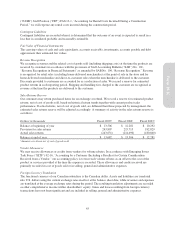Pottery Barn 2005 Annual Report Download - page 47
Download and view the complete annual report
Please find page 47 of the 2005 Pottery Barn annual report below. You can navigate through the pages in the report by either clicking on the pages listed below, or by using the keyword search tool below to find specific information within the annual report.
stores for which current cash flows from operations are negative, or the construction costs are significantly in
excess of the amount originally expected. Impairment results when the carrying value of the assets exceeds the
undiscounted future cash flows over the life of the lease. Our estimate of undiscounted future cash flows over the
lease term (typically 5 to 22 years) is based upon our experience, historical operations of the stores and estimates
of future store profitability and economic conditions. The future estimates of store profitability and economic
conditions require estimating such factors as sales growth, employment rates, lease escalations, inflation on
operating expenses and the overall economics of the retail industry for up to 20 years in the future, and are
therefore subject to variability and difficult to predict. If a long-lived asset is found to be impaired, the amount
recognized for impairment is equal to the difference between the carrying value and the asset’s fair value. The
fair value is estimated based upon future cash flows (discounted at a rate that approximates our weighted average
cost of capital) or other reasonable estimates of fair market value. See Note A to the Consolidated Financial
Statements for additional information regarding Property and Equipment.
Self-Insured Liabilities
We are primarily self-insured for workers’ compensation, employee health benefits and product and general
liability claims. We record self-insurance liabilities based on claims filed, including the development of those
claims, and an estimate of claims incurred but not yet reported. Factors affecting this estimate include future
inflation rates, changes in severity, benefit level changes, medical costs and claim settlement patterns. Should a
different amount of claims occur compared to what was estimated, or costs of the claims increase or decrease
beyond what was anticipated, reserves may need to be adjusted accordingly. We determine our workers’
compensation liability and general liability claims reserves based on an actuarial analysis. Reserves for self-
insurance liabilities are recorded within accrued salaries, benefits and other on our consolidated balance sheet.
Revenue Recognition
We recognize revenues and the related cost of goods sold (including shipping costs) at the time the products are
received by customers in accordance with the provisions of Staff Accounting Bulletin (“SAB”) No. 101,
“Revenue Recognition in Financial Statements” as amended by SAB No. 104, “Revenue Recognition.” Revenue
is recognized for retail sales (excluding home-delivered merchandise) at the point of sale in the store and for
home-delivered merchandise and direct-to-customer sales when the merchandise is delivered to the customer.
Discounts provided to customers are accounted for as a reduction of sales. We record a reserve for estimated
product returns in each reporting period. Shipping and handling fees charged to the customer are recognized as
revenue at the time the products are delivered to the customer.
Sales Return Reserve
Our customers may return purchased items for an exchange or refund. We record a reserve for estimated product
returns, net of cost of goods sold, based on historical return trends together with current product sales
performance. If actual returns, net of cost of goods sold, are different than those projected by management, the
estimated sales return reserve will be adjusted accordingly.
Income Taxes
Income taxes are accounted for using the asset and liability method. Under this method, deferred income taxes
arise from temporary differences between the tax basis of assets and liabilities and their reported amounts in the
consolidated financial statements. We record reserves for estimates of probable settlements of foreign and
domestic tax audits. At any one time, many tax years are subject to audit by various taxing jurisdictions. The
results of these audits and negotiations with taxing authorities may affect the ultimate settlement of these issues.
Our effective tax rate in a given financial statement period may be materially impacted by changes in the mix and
level of earnings.
Stock-Based Compensation
We account for stock options and awards granted to employees using the intrinsic value method in accordance
with Accounting Principles Board Opinion No. 25, “Accounting for Stock Issued to Employees.” No
35
Form 10-K



